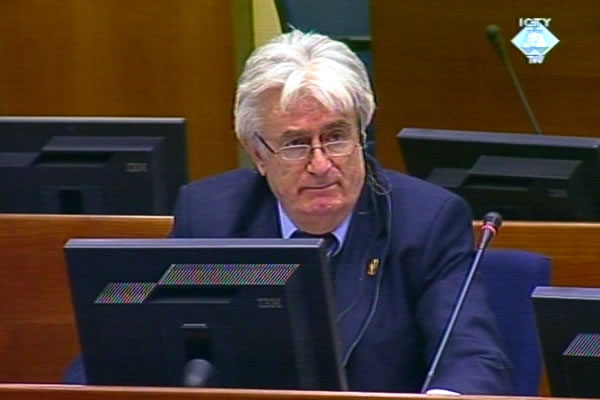Home
CLIMATE OF FEAR AND TERROR IN SARAJEVO
High-ranking UNPROFOR officer testifies at the trial of Radovan Karadzic with protective measures. According to the witness, the attacks on the citizens of Sarajevo were part of a global strategy to ‘create a climate of fear and terror’ among the civilians. General Ratko Mladic was the ‘main strategist’ and General Dragomir Milosevic was a ‘hands-on man’ in charge of implementing the strategy in the Sarajevo area in 1994 and 1995, the witness claimed
 Radovan Karadzic in the courtroom
Radovan Karadzic in the courtroom The evidence of former president of the Ilidza Crisis Staff Nedjeljko Prstojevic at the trial of Radovan Karadzic was interrupted to allow the prosecution to call a high-ranking UNPROFOR officer testifying under the pseudonym KDZ 182. The witness’s written statement based on his previous testimony before the Tribunal, again with protective measures, was admitted into evidence. The witness is testifying in French and is believed to be a high-ranking officer of the French armed forces.
The prosecutor read out a brief summary of the witness’s statement. The witness did his tour of duty in the UN force in Sarajevo in late 1994 and in 1995. In that period, the Bosnian Serb forces regularly opened sniper and artillery fire on the civilians in Sarajevo. UNPROFOR protested against the targeting of civilians just as regularly, but the commander of the VRS Sarajevo-Romanija Corps Dragomir Milosevic either didn’t respond to the protests or claimed that Muslims had fired first.
As the witness said, civilians were the main target of the Serb artillery, while BH Army military facilities were ‘accidental targets’. The attacks on civilians were part of a global strategy to ‘create a climate of fear and terror’ among the citizens, the witness explained. According to him, General Mladic was the main ‘strategist’. General Milosevic was ‘the hands-on man’ in charge of implementing the strategy in the Sarajevo area. The witness said that Milenko Indjic, former VRS liaison officer with UNPROFOR, was ‘Mladic’s eyes and ears’, making sure that the SRK operations were in line with Mladic’s general strategy.
The prosecutor brought up an order General Mladic issued on 6 November 1994, where the former commander of the VRS Main Staff institutes ‘a ban on any fire from the heavy large-caliber artillery on civilian targets...without my explicit order and approval’. The witness said the order corroborated the claim that Mladic ‘conceived, controlled and supervised’ the targeting of civilians in Sarajevo.
The Trial Chamber granted Karadzic five hours for the cross-examination of witness KDZ 182. Karadzic asked for more, saying that the witness’s consolidated statement was ‘full of generalized descriptions, opinions and impressions’, that it was ‘very arbitrary and therefore dangerous’ and that it ‘carries the weight of an entire indictment’. The judges rejected Karadzic’s request, saying that the Trial Chamber has already seen the accused ‘squandering’ the time given to him for the cross-examination.
Karadzic again tried to use this witness to prove that the other side targeted its own civilians and engaged in a variety of other ‘war ruses’ to ‘blame the Serbs’ and ‘draw the UN into the conflict’. The witness dismissed the claims, noting that Serbs were responsible for most of the incidents. Karadzic then put it to the witness that this was ‘mere guesswork’ but the witness disagreed, saying his assessments were based on personal observation, conversations, analyses and investigations carried out by UNPROFOR. Based on these data, the witness was able to conclude ‘beyond any doubt’ that the civilian population was ‘exposed to the Serb aggression’. ‘Those are not assumptions based on smoke’, the UNPROFOR officer concluded.
Linked Reports
- Case : Karadzic
- 2011-03-03 JUDGES ADMONISH BOTH THE ACCUSED AND WITNESS
- 2011-03-02 WHOSE HOUSES WERE TO BE BLOWN UP?
- 2011-03-01 KARADZIC: PROSECUTION WITNESS AS ‘EXTREMIST’
- 2011-03-10 RAPE UNSUITABLE FOR POLICE REPORT
- 2011-03-11 RAPE VICTIM: I WILL WAIT PATIENTLY FOR JUSTICE
- 2011-03-15 AKASHI WAS ‘IRRESISTIBLE’, KARADZIC ‘TOLERANT’
